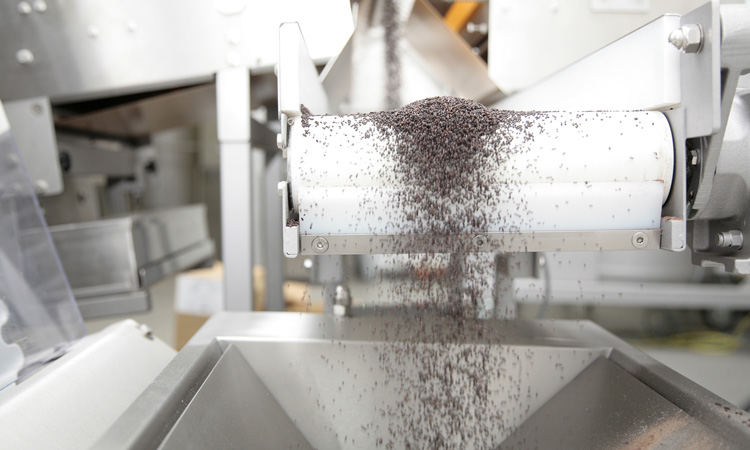Mitigating risk with food grade lubricants
- Like
- Digg
- Del
- Tumblr
- VKontakte
- Buffer
- Love This
- Odnoklassniki
- Meneame
- Blogger
- Amazon
- Yahoo Mail
- Gmail
- AOL
- Newsvine
- HackerNews
- Evernote
- MySpace
- Mail.ru
- Viadeo
- Line
- Comments
- Yummly
- SMS
- Viber
- Telegram
- Subscribe
- Skype
- Facebook Messenger
- Kakao
- LiveJournal
- Yammer
- Edgar
- Fintel
- Mix
- Instapaper
- Copy Link
Posted: 20 November 2019 | Denis Treacy | No comments yet
Equipment lubricants are vital in ensuring a plant runs safely and efficiently, but can create further risks if not regulated effectively. Here, Denis Treacy of Culture Compass Ltd, explains…


One group of contaminants often overlooked in a food manufacturers’ HACCP plans are equipment lubricants. These are vital in ensuring a plant runs safely and efficiently, but which, without careful consideration as a genuine risk – particularly those hydrocarbon-based – can become one of the growing list of reasons to create waste, reject product, suffer an audit non compliance or even recall a production batch, with all the commensurate costly consequences.
The solution is in the design of a manufacturing facility to ensure any risk from moving parts is assessed and controlled or designed out completely. This can range from off-setting gearboxes so shafts do not allow the travel of leaks directly into the product, double seat seals to retain leaks, routing conveyors away from overhead drive motors and bearings, the installation of tray units under equipment with gearboxes and the filtering of pneumatics which may push oil-contaminated air into process flows.
Mitigation of risk from the unintentional contamination of food processes and food products from lubricants is by the use of lubricants classified as food-grade. These are lubricants which are made from materials identified as acceptable for use in food processing and manufacturing.
Mitigation of risk from the unintentional contamination of food processes and food products from lubricants is by the use of lubricants classified as food-grade.
Although all manufacturers of food-grade lubricants will have their own formulations, generally they are made from a base stock of vegetable oils which, because they will oxidise in time, have food-grade additives and thickeners or hydrolised oils if required as greases. Food-grade lubricants are developed to mimic the role and functionality of hydrocarbon or synthetic lubricants in delivering the unique challenges of food processing. As such, lubricants used in the food industry have requirements, protocols and performance expectations that go well beyond typical industrial lubricants.
Food processing requires machinery such as pumps, refiners, mixers, agitators, depositors, sifters, tanks, hoses and pipes, chain drives and conveyor belts. Food-grade lubricants must offer sustainable protection of internal surfaces to control friction, wear, corrosion, heat and deposits. They must also be practical and functional, with good pumpability and offer oxidation, hydrolytic and thermal stability.
In addition, they must be able to dissipate heat, transfer power, be compatible with rubber, silicone, plastics and other sealing materials as well as providing sealing effects themselves. They must resist degradation and impaired performance when in contact with food products, certain process chemicals, water and steam, and they must prohibit the growth of bacteria, yeast and fungi and have the ability to dissolve sugars, all while remaining physiologically inert, tasteless, odourless and internationally approved.
One of the biggest challenges a food-grade lubricant will face is from chocolate. Refining chocolate requires the reduction in particle size of cocoa solids, milk powders and granulated sugar. The process, depending upon the final use, asks equipment to grind and reduce huge volumes of this granular paste down to less than 30 microns. What is effectively a grinding paste itself will eat through the knives and rollers of a chocolate flake mill in days. This paste will also work its way into bearings, the seals of pumps and eventually into the lubricants contained within. The need to ensure a lubricant is capable of retaining functionality, while offering no risk to the integrity of the product is the challenge for food processors, equipment and lubrication manufacturers alike.
The USDA has categorised food-grade lubricants into three broad groups:
- USDA H-1 – True food-grade. These are lubricating compounds permitted on equipment where food may potentially be exposed to the lubricated part of the machine. These instances are referred to as incidental contact surfaces and this represents a risk of food materials being offered back into the process once contact with the lubricated equipment has been made. These lubricants must be composed of materials listed as acceptable by the USDA document 21 CFR 178.3750
- USDA H-2 lubricants are compounds used in food-processing plants on equipment in locations where there is no possibility of the lubricant or lubricated part of the machine to contact edible products
- USDA H-3 compounds are water-soluble oils. These are required to be cleaned and the emulsions removed from food processing equipment before use in food production.
In addition, the German Institute for Standardisation (DIN) has submitted a German standard as a draft to the International Organization for Standardization (ISO) in Geneva. It may take up to three years from the date the application is accepted for an international standard to be released.
In summary, the responsibility of food processors and manufacturers remains to ensure they have appropriately and competently risk-assessed their processes and resourced the appropriate condition-based monitoring, vibration and lubricant analysis, together with repair and maintenance schedules to protect against failure and contamination. The contents of food produced must be declared on the packaging, so even with the development and use of food-grade lubricants, as with allergen warnings, it is not permissible or acceptable to operate in a manner that allows anything beyond incidental additions of such materials into processes where they are not part of the formulation.
About the author
Denis Treacy heads Culture Compass Ltd, which serves to help businesses, industry institutes and government departments step-change performance by understanding the links between policies, organisation and performance, but through the critical elements of optimal strategy and positive behaviours. Denis is known in the food industry for sharing best practices, working with customers, regulators and competitors alike to better the industry. Denis has many areas of expertise including the delivery of transformational performance improvements in areas of safety and quality strategy, continuous improvement, business culture, change management and organisational transformation.
Related topics
Food Grade Lubricants, Food Safety, Health & Nutrition, Processing, Supply chain









